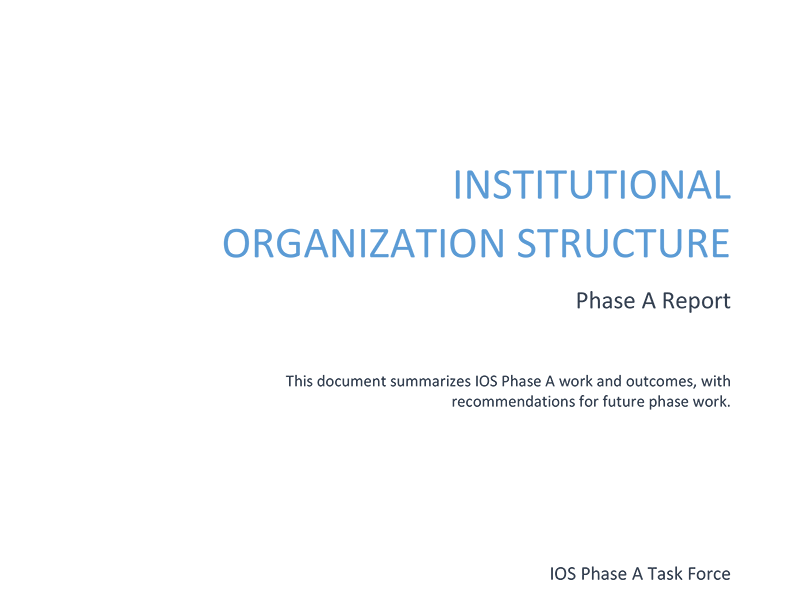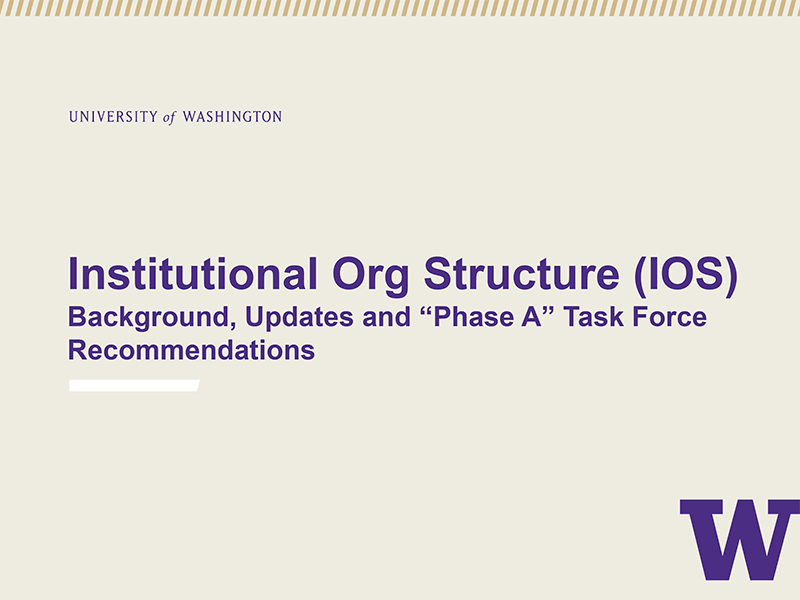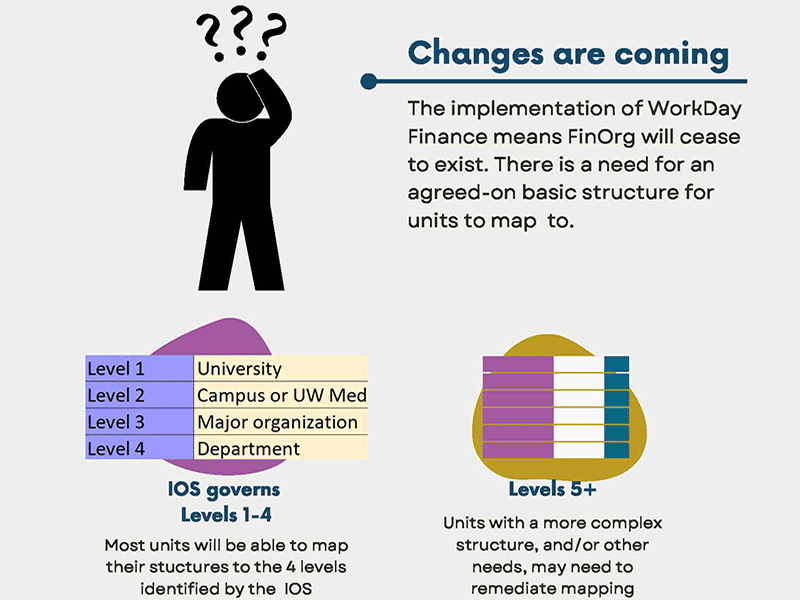ON THIS PAGE:
Overview and Current Status
The Data Governance Steering Committee chartered a phased task force in May 2021.
Phase A is complete
The phase A task force was charged to document the basics of levels 1-3 of the Institutional Org Structure (IOS), determine and document level 4, and the criteria units will need to meet for the structure prototype, including tools, process, and definitions related to level 4.
- June/July 2021: task force met with key campus groups to review and vet the emerging structure.
- August 2021: drafted proposed IOS structure
- September 30, 2021: task force completed its report and submitted it to Data Governance, and the Administrator’s Council
IOS Report

Read the IOS Phase A task force report
[NetID required]
IOS Slides

Check out IOS Slide Deck
[NetID required]
IOS Visuals

Review the IOS infographic
[NetID required]
Phase B is complete
The task force met with a series of stakeholders to share the draft levels and gather input:
- October 12 Data Governance information session
- October 20 Data Governance Operations Committee
- October 22 Data Governance Steering Committee
- October 26 President’s Cabinet
- October 27 Finance Data Domain Council
- October 28 Administrator’s Council
- November 8 Office of Academic Personnel leadership
- November 9 UW Medicine leadership
Phase C
The phase C task force has completed a draft IOS structure for levels 1-4 and in January/February 2022 is reporting back to the Data Governance Steering Committee and Operational Committee. A key recommendation is for a dedicated resource to conduct an interim confirmation period phase to solicit feedback from the enterprise.
Future Phases
With UW Data Governance endorsement of the phase C task force recommendations, the data domain councils will direct mapping at the unit level, so that existing data structures may be mapped to the new IOS. Decisions about a support tool and ongoing maintenance must also be addressed.
Background
Although the UW has an “official” org structure outlined in APS 1.1, this structure is not codified in UW’s systems or technology platforms. The financial structure established in FAS has come to serve this purpose and is known as the “FinOrg”. Other enterprise systems (space, students, research, and advancement) have adapted their architecture to adhere to FinOrg.
With the implementation of Workday Finance, FAS will cease to exist. Even though FinOrg is broadly used, it is not sanctioned as the UW’s institutional structure. A formally sanctioned IOS will provide the “spine” to which Workday and all other enterprise systems can align and ensure interoperability in reporting and analytics across technology and data domains. The IOS will provide a consistent approach to keep decentralized systems in sync.
Prior reports
- February 2021 working group recommendation: [NetID required] Policy Analysis and Technical Options—IOS and Administrative Policy Statements
- October 2020 IOS Task Force report [NetID required]
FAQs
Yes and no. The FinOrg is going away but this work is not a 1:1 replacement of the FinOrg structure, rather a backbone infrastructure piece to which the different data domains (finance, HR, student, research, space, etc) will be required to map. The mapping of this core data element will not replace domain hierarchies currently used (e.g., Supervisory Org Structure, Academic Org Structure, Cost Center Hierarchy). This will supplement those structures, enabling cross-domain reporting and analysis.
- If you use the FINORG for financial reporting or financial routing, the WD Cost Center Hierarchy (CCH) should be used as a future replacement
- If you use the FINORG for position or HR reporting, the WD Supervisory Organization (SupOrg) should be used as a future replacement (assuming SupOrg remediation)
- If you use the FINORG for academic or AHR reporting, the WD Academic Hierarchy should be used as a future replacement
- The IOS is meant to provide a consistent institutional structure that both maps and maintains consistency across all enterprise organizing structures at key levels (namely, executive entity and department levels).
- The IOS will not have the depth that FinOrg currently provides. If there is a need for reporting or workflow processes with greater detail, a different enterprise structure will need to be used.
- The IOS is designed to bridge the gap between the various domain-specific hierarchies, to enable cross-domain and cross-function reporting and analysis. It is not meant to replace any domain-specific hierarchy.
- IOS-related communications are underway to ensure our colleagues are aware of how this work is unfolding and how it aligns with FT requirements, timelines, and deliverables.
- Work currently underway is focused on a recommendation to align with or modify existing Administrative Policy Statement (APS) 1.1 along with proposed options for technical solutions from UW-IT.
- Once a decision point is reached with regard to APS, further outreach will occur to institutional stakeholders to work through what’s identified as “Level 4” in the IOS recommendation, with an aggressive target completion date of April 1st, contingent largely on the ability to receive approved structures back from the community and review of those structures against APS policy (primarily related to academic departments).